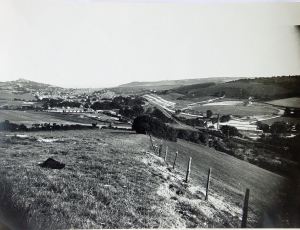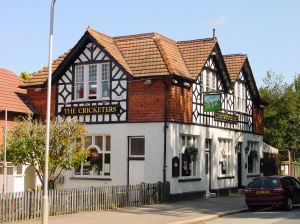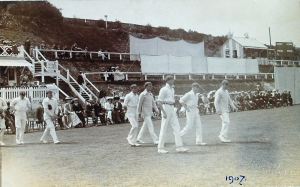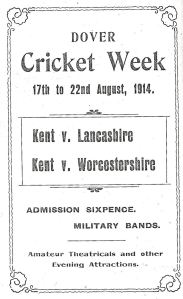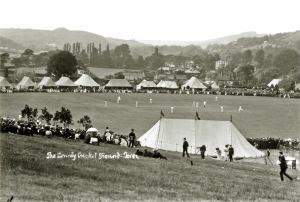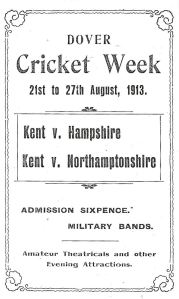In 1896, Dover cricket ground, which was on land that Millais and Leighton Road were built, was put up for sale. Cricket had been played in Dover for a very long time, indeed, the first recorded match took place on the 6 August 1753 when the town met Dartford at Coombe Hole, Buckland. Nothing much else is on record until 1851, when the house that was later to become part of the Royal Victoria Hospital, on the High Street, was auctioned. At that time, the town’s cricket matches were being played on the adjoining meadows and the building of Wood Street led to the move to where Millais and Leighton Roads are now.
Alfred Charles Leney (1860-1953), the brewer, Francis Finnis, Henry Hayward – surveyor and James Stilwell – solicitor, formed a syndicate and purchased land from Bunkers Hill to Crabble railway bridge, called Crabble Meadows. Previously the part of the meadow under what is now the Dover Athletic football pitch had been used by Dover Football Club. Of the remaining area, the syndicate agreed that 14 acres were for an athletic ground of which eight acres were to be levelled to form a cricket ground.
Henry Hayward’s son, Fred – an architect – designed and developed the site, which included the 8-acre perfect oval area for cricket. The famous cricketer, Alec Hearne (1863–1952), laid out the quick draining/drying playing surface. Arthur Munns, who played for Kent on one occasion, was appointed groundsman. Surrounding the state-of-the-art cricket pitch an asphalt cycle track was constructed. At the side were tea lawns and a pavilion. Later, a winding road interspersed with flowerbeds and shrubberies was laid and has since matured into a very nice walk.
While all this was going on the syndicate had set up ‘The Dover Athletic Ground Ltd’ with an authorised share capital of £8,000 in shares and £4,000 in bonds. The costs were anticipated to be £10,000 and included £5,500 for levelling, £1,000 for a pavilion, £1,000 for turf and £600 for the cycle track. Although the syndicate were keen businessmen, these expenses plus the cost of purchase of the land meant that there was little margin for unknowns. Nonetheless, the work was completed and on Whit-Monday 1897, George Wyndham, Member of Parliament for Dover (1889-1913), opened Crabble Athletic Grounds, to great fanfare. That day athletics and cycling were the main events.
At the time, on the site now occupied by the Cricketers’ pub, there appears to have been a hostelry run by Frank Leney, the younger brother of Alfred C Leney and son of the brewer, Alfred Leney (1837-1900). Previously there had been a tin hut owned Total Abstinence Society. The land purchased by the consortium included this and Alfred C Leney, who was toying with the idea of building a hotel nearby, bought the hostelry from the syndicate, enlarged it and renamed it Cricketers’ Arms.
Although the ground proved to be popular, it was a court case that hit the syndicate hard. In 1898, Champion cyclist Robert Bennett, who was under contract with Dunlop Tyre Company, filed a High Court lawsuit against the syndicate. This was for injuries he sustained while training, when a small dog ran across the track and he fell off his bicycle. Although Bennett’s legal battle failed, the syndicate were not given costs.
To try to offset this unexpected expense, the syndicate sought to bring county cricket to the town and in 1899, Marylebone Cricket Club (MCC) played at Crabble. The following year, even though the town held a successful cricket festival, the syndicate was running into severe financial difficulties and decided to sell Crabble for housing. However, Dover Corporation stepped in and bought the ground for £5,500 in 1902.
The Mayor of Dover at the time was Sir William Crundall (1847-1934) and on 19 September 1899 he organised Dover’s first motorcar exhibition at the Ground. Members of the Automobile Association drove down from London for the event and 25 or 26 vehicles of various types took part in a grand parade round the cycle track. It was reported that the ‘most handsome vehicle’ was an electric phaeton that the Mayor was driving and belonged to Alfred Harmsworth (1865-1922), later 1st Viscount Northcliffe, the owner of the Daily Mail newspaper. Other vehicles included a velocipede – a human powered vehicle, these days called quadracycles, that had probably been made by Dover’s Willard Sawyer (1808-1892) the ‘first truly professional maker of man-powered vehicles’. There were also electric cars, a lorry, a motor dogcart and a motor tricycle. Driving a Panhard was Charles Rolls (1877-1910), who on 2 June 1910 made the first none-stop flight across the Channel and back again. Also in the parade was the new Pioneer – the new steam vehicle belonging to the Dover and East Kent Motor Bus Company. Following the parade, there were free rides on the Pioneer until the driver drove it off the track onto the grass where it sank almost to the axles!
In 1905, moves again were made to bring county cricket to Dover but it was not accomplished until 1907. Between 11-13 July that year, 13,000 spectators saw Kent beat Gloucester, with a team including, Bill Fairservice, Frank Woolley, Charlie Blythe, Arthur Fielder, James Seymour, Jack Mason, Dick Blaker, Edmund Hardinge, Punter Humphreys and captained by Cloudesley Henry Bullock Marsham (1879-1928).
The following year the streets, shops and every tram in Dover were festooned with decorations. Special trains were laid on and with so many fans coming to the town, every hotel and guesthouse was full. They were not disappointed for Kent first played Yorkshire and then Somerset with James Rothery (1877–1919) setting a record by scoring 161 runs. By 1908, it appears that Henry Hayward owned the former football pitch, for that year he put the land up for sale advertising plots, ‘overlooking this magnificent Cricket Ground and tram line.’ However, the plots did not sell. In 1911 crowds saw Kent play Nottinghamshire then Leicestershire, the latter setting the record for the highest team totals of 530 for 6 declared, a record that was to last until 1935.
County Cricket at Crabble was suspended during World War I (1914-1918) but returned in 1919 when Kent played Yorkshire. The following year it was decided that Cricket week would be spectacular and reception marquees were provided by Lord George Hamilton, Earl Beauchamp, Connaught Rangers, Royal Irish Fusiliers, Dover Cricket Club, the Commercial Club (Chamber of Commerce) and Dover Corporation. Dover Cricket Week was back on the County agenda and people flocked to the town. In 1922, George Collins (1889-1949) set an unbeaten record at Crabble, taking 16 wickets for 83 when Kent played Nottinghamshire.
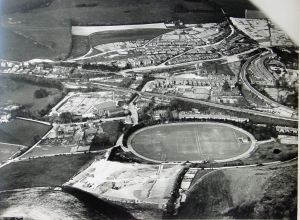
Crabble cricket ground with the new football pitch, constructed by the unemployed 1929-1930, nearer the camera. Dover Library
From the outset of the council owning Crabble, they had allowed, during the winter season, football to be played on the cricket pitch. Following the War, the football season had increasingly encroached at the end of the cricket season. Matters came to a head in 1924 and the council called meeting between Leney and Henry Youden, for the Cricket committee and Herbert Geddes for the Dover United Football Club. Geddes apologised but blamed the Football Association, who set the fixtures. It was suggested that if money came available a new football ground would be laid at the back of the Athletic Ground on the old football ground.
Leney undertook to make enquiries as to who owned the land in order to acquire it and the Borough Surveyor, William Boulton Smith, prepared the plan, estimated costs etc. for a new pitch. An application was made to the Unemployment Grants Committee and in 1929, this came through. The new football ground, utilising the unemployed and estimated at £10,000 was laid next to the cricket ground and the following year, the first full season was played there. It is now the home ground of Dover Athletic Football Club. Cricket week continued to be a crowd-puller with the correspondent for the Manchester Guardian, in 1931, wrote ‘ The field just outside Dover, is fit for a cricketer’s seventh heaven …’
The Silver Jubillee of the ascension of George V (1910-1936) to the throne was celebrated on 10 May 1935, when 3,000 Elementary School children wearing red, white and blue, formed living patterns one of which was the Union Jack. Two years later, on Wednesday 12 May for the coronation of George VI (1936-1952) the same configeration was repeated along with other pictoral demonstrations. This took place on 30 July 1937 due to a heavy thunderstorm and down pour on Coronation Day, Wednesday 12 May.
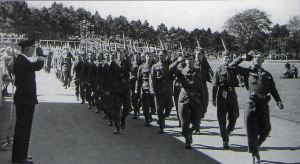
Crabble Athletic Ground – Home Guard officially stood down in December 1944 and were part of the victory celebrations at Crabble Athletic Ground in 1945. The photograph was taken in 1943. Jim Davis
In 1935, Kent played Lancashire and then Derbyshire, and in the latter game, Bill Ashdown (1898–1979) made 305 runs, a record that was never beaten at Crabble. Cricket Week in August 1937 saw the county play against Gloucestershire with the visitors scoring 434 runs in the first innings. Kent scored 399 but Gloucester responded with a further 182 runs. This left Kent to make 218 runs in just two hours, if they were to win. Kent achieved this with the loss of just two wickets! The last inter-war First class cricket match opened on 26 August 1939, just days before war broke out, and Arthur Fagg (1915-1977) made 138 runs helping Kent beat Lancashire. For the duration of World War II Crabble became the headquarters of the Royal Corps of Signals and my Father, who was there in 1940, proudly boasted that he played cricket on the same ground as the cricketing greats of the time!
County Cricket resumed in 1946 when Kent beat Glamorgan at Crabble. Dovorian, Eddie Crush (1917-2007), renowned for his bowling, during Australia’s Ashes tour in 1948, bowled out the legendary Australian batsman Don Bradman (1908-2001). During his first class career that lasted from 1946 to 1949, Eddie took 83 wickets and made 1,078 runs. In 1948, the Crabble crowd also watched Arthur Fagg score 203 runs while Eddie made 50 runs against Middlesex. Dover’s Cricket Week had returned to its full pre-war glory!
In 1953, Doug Wright (1914-1998) took 12 wickets for 102 when Kent beat Somerset. This was the most wickets ever taken in a single match at Crabble. In 1961, an estimated crowd of 10,000 watched Peter Richardson (b1931) score 132 runs when Kent beat Northamptonshire. Nonetheless, the Corporation complained that they were paying all the costs for County Cricket but not reaping the benefits, so cut back on maintenance. The fact that the town not only received the accolades of holding First class cricket it reaped a lot financial benefits from visitors to the town who came to watch. However, the council stuck to its guns and by 1964, because of the poor state of the wicket, it was announced that there would only be one more County match at Dover.
First class cricket did continue, as did Cricket Week, but First class cricket at Crabble was doomed. In 1970, the Dover Cricket Week was trimmed to four days with a county championship match and a Gillette Cup fixture against Northamptonshire. During the three-day fixture, MCC’s inspector of pitches, Bert Lock, was called in and ruled that Crabble was to be dropped from the Kent cricketing circuit. Money was spent on bringing the wicket up to standard and the First class cricket returned in 1972. That year, crowds – including this author and her father – saw Colin Cowdrey (1932-2000) score 107 runs.
On 1 April 1974, Dover District Council (DDC) was born and it was hoped that the cricket pitch would be upgraded – the new council gave just £350 for this! That year Derek Underwood (b1945) caught 12 for 80 when Kent beat Gloucester at Crabble. The following year Asif Iqbal (b1943) scored 107 runs when Kent beat Nottinghamshire. In July 1976, Kent beat Derbyshire by 62 runs but the match was a financial failure due to lack of spectators. This was the final County match was played at Crabble for the following month the Test and county pitch inspector, Bernard Flack, failed the pitch for the following year’s fixtures.
Dover Cricket Club ensured that cricket continued at Crabble and this produced such local stars such as Chris Penn (b1963) who, in 1978 became Dover Schools’ cricket captain and also played for England boys. The fast bowler, in 1982, made his debut for Kent against Glamorgan and played for Kent until 1994, when he was forced to retire through a shoulder injury. Chris had joined another Dovorian, Derek Aslett, in the Kent squad – 1981 saw the start of Derek’s six-year career with the County team. In recognition to both DDC laid a £3,000 artificial wicket at Elms Vale Recreation Ground. While at Crabble, the cricket pavilion was renovated at a cost of £120,000. This was officially opened in October by the then Chairman of Dover District Council, Councillor Walter Robertson with a game between Dover Rugby Club and a Kent XV. That year, however, did see the birth of the Dover and District Cricket League, which produced, amongst others, Richard Pepper who played for England’s Schools’ and his brother Stuart.
There was talk of First class cricket returning to Crabble, but the cost of bringing the ground up to standard made it prohibitive. Instead, DDC found it more lucrative to rent the ground for boot fairs and soon they took precedence over cricket fixtures. Although still enjoying success the Dover Cricket Club folded in the 1990s and now Rugby is played on the former cricket ground.
- Published:
- Dover Mercury: 15 & 22 November 2007

